
Guests
- "Fire in the Heartland"excerpt from the new documentary 'Fire in the Heartland: Kent State, May 4th, and Student Protest'.
- Gene Youngwitness to the Jackson State tragedy and longtime civil rights activist. He began his activism as a pre-teen, getting arrested for civil disobedience at a bus station at the age of twelve. Before his thirteenth birthday, Young took his first plane ride to New York to speak to civil rights groups. He attended the 1963 March on Washington and testified at the House of Representatives, alongside civil and voting rights activist Fannie Lou Hamer. He has continued his activism to this day and was a featured speaker last week at an event commemorating the fortieth anniversary of the Kent State shootings.
Four decades ago, on May 4, 1970, four students were killed at Kent State University when National Guardsmen opened fire on hundreds of unarmed students at an on-campus antiwar rally. The killings received national media attention and are still remembered forty years later across the country. But the media has largely forgotten what happened just ten days after the Kent State shootings. On May 14, 1970, local and state police opened fire on a group of students at the predominantly black Jackson State College in Mississippi. In a twenty-eight-second barrage of gunfire, police fired hundreds of rounds into the crowd. Two were killed and a dozen injured. We speak with Gene Young, a former student at Jackson State who witnessed the shooting. [includes rush transcript]
Transcript
JUAN GONZALEZ: Four decades ago, four students were killed at Kent State University when National Guardsmen opened fire on hundreds of unarmed students on an on-campus antiwar rally. The killings received national media attention and are remembered forty years later across the country. But the media has largely forgotten what happened just ten days after the Kent State shootings. On May 14th, 1970, local police opened fire on a group of students at Jackson State College in Mississippi. In a twenty-eight-second barrage of gunfire, police fired hundreds of rounds into the crowd. Two were killed and a dozen injured. The Jackson State shootings didn’t receive close to the attention from the media that Kent State did.
AMY GOODMAN: Howard Zinn, the late, great historian and author of A People’s History of the United States, spoke about why the Jackson State killings were largely ignored in his very last interview we did with him on Democracy Now! just last May.
HOWARD ZINN: Yeah, well, it’s a very common thing in history to ignore the things that happen to black people. And, of course, the Kent State shooting was a very dramatic and terrible event and deserves to be remembered as one of those shameful things in American history. But the media tend to focus on some things and not on others, and the media did not focus on the other shooting that took place at Jackson State, where two black youngsters were gunned down. And so, yeah, I think our job as historians is to bring out things that we did not get ordinarily in our history lessons.
JUAN GONZALEZ: That was historian Howard Zinn speaking last year.
Well, today on this fortieth anniversary, we remember the Jackson State shootings. This is an excerpt from the documentary Fire in the Heartland that includes a section on Jackson State. It features interviews with Gene Young, who was a student at the time and who witnessed the shootings, and Gloria Green McCray. Her brother, seventeen-year-old James Green, was one of those two students killed.
NARRATOR: Just after midnight on May 15th, seventy officers from the city police and state troopers opened fire on protesters near the women’s dormitory, Alexander Hall.
GENE YOUNG: They saw a male figure on the fourth floor stairwell landing. The next thing you know, you hear rapid gunfire erupting in the direction of the students and all around.
NARRATOR: Twelve students were wounded, and two were killed. Phillip Lafayette Gibbs was a twenty-one-year-old law student, already married and a father of an eleven-month-old son. James Earl Green was a seventeen-year-old high school track star standing on the opposite side of the street when police turned and fired.
GLORIA GREEN McCRAY: They had a nickname for him: “Wing Feet.” He would run so fast, and when he’d get to a certain distance, it looked like he took wing and flew.
NARRATOR: Green cut across campus every night on his way home from work. He was only two weeks from his high school graduation.
GLORIA GREEN McCRAY: All he talked about, “I’ll be graduating in a couple of weeks. I’ll be leaving Mississippi, going to California, going to UCLA. I’m going to run in the Olympics,” you know? He was just an innocent bystander, but they had orders to shoot anything black that moved.
NARRATOR: As the gunsmoke cleared, Gene Young tried to calm the traumatized students.
GENE YOUNG: And I just grabbed the bullhorn, and out of that tragedy, I just start repeating some of the words of Dr. King to the students there on the lawn. “I have a dream that one day the state of Mississippi, a desert state sweltering in the heat of injustice and oppression, will be transformed into an oasis of freedom.” And on and on I went to recite that particular speech. The students focused on my words rather than the great tragedy which had just occurred around them and which was still occurring around them.
NARRATOR: The second tragedy of Jackson State was that the national media paid very little attention to the murder of those two black students in Mississippi.
UNIDENTIFIED: Those students were black. The students who died at Kent State were white. Very simple.
GLORIA GREEN McCRAY: He had so much to live for. My brother’s life was just as important as Medgar Evers, Martin Luther King, Emmett Till or any other martyrs that gave up their life, that sacrificed their life for the right of the people.
AMY GOODMAN: An excerpt of the documentary Fire in the Heartland. That last voice was Gloria Green McCray talking about her brother James Green, who was one of the two students killed at Jackson State forty years ago today. You also heard Gene Young. He was a student at Jackson State. He witnessed the shootings.
Well, Gene Young flew up from Jackson, Mississippi to join us today on Democracy Now! on this fortieth anniversary of the Jackson State killings. Gene Young is a longtime civil rights leader. He began his activism as a preteen, getting arrested for civil disobedience at a bus station at the age of twelve. Before his thirteenth birthday, Young took his first plane ride to New York to speak to civil rights groups. He attended the 1963 March on Washington. He testified at the House of Representatives alongside civil and voting rights activist Fannie Lou Hamer. He’s continued his activism to this day and was a featured speaker last week at an event commemorating the fortieth anniversary of the Kent State shootings in Ohio.
Gene Young, we welcome you to Democracy Now!
GENE YOUNG: Thank you, Amy. Thank you, Juan. Good morning.
AMY GOODMAN: It’s very good to have you with us. Let’s go back forty years. Talk about what was happening at Jackson State. You were a student there? What year?
GENE YOUNG: I was a student there from 1968 to 1972, and as you noted, I had been involved in a lot of civil rights activities. And Jackson State is located right there on Lynch Street, right near the Masonic Temple where Medgar Evers had his offices. And ironically, when I got out of jail the first time I got arrested for civil rights protest, Lena Horne and Dick Gregory were at a mass meeting which Medgar Evers hosted, and I got a chance to stand up in a chair to try to encourage people to join the civil rights protest, and Lena Horne kissed me that night.
A few years later, because of Lynch Street being a major thoroughfare there in Jackson, there was always a lot of racism, white motorists making racial taunts towards the students, and things just came to a head days after the shootings of the students at Kent State University. Mississippi law enforcement officials walked onto the campus and stood in front of the students who were assembled in front of Alexander Hall dormitory, and for twenty-five seconds they fired over 200 rounds of ammunition at the students in front of Alexander Hall dormitory.
And the miracle of that particular May morning in 1970 was that only two students got killed — if you ever see the pictures of all of the bullet holes in the dormitory. Phillip Gibbs, a junior, a prelaw major from Ripley, Mississippi, and James Earl Green, a young high school student who was on his way home from a part-time job at one of the local convenience stores, were murdered that morning.
JUAN GONZALEZ: Now, what was the original cause of the students gathering that night, because it was right after the Kent State shootings?
GENE YOUNG: Juan, at that time, you know, we had had several nights of protests, not only because of what was going on at Kent State, but every campus in this country was in an uproar about the war in Vietnam. And black — young black males were being sent to Southeast Asia in disproportionate numbers, and we were concerned about that, in addition to the historic racism there in Jackson, Mississippi. So there were several nights of protests. And I was thinking that there would just be some taunts and jeers at the law enforcement officials present and thinking nothing would happen, but shortly after midnight, on that third night, early in the morning, May 15, actually, those students were fired upon at Jackson State.
JUAN GONZALEZ: And for viewers who are not — or listeners who are not familiar with the situation in Jackson, because, as you mentioned, it was always a hotbed of activity in terms of the battle for civil rights, what was the climate —- for instance, the media. You had WLBT TV there. You had the Jackson Daily News, the Clarion Ledger, all of them notorious defenders of segregation at the time. What was the climate like?
GENE YOUNG: Yeah, and, of course, that was business as usual, you know? And I shared with you a picture of me meeting with Mrs. Fannie Chaney, whose son was one of the three civil rights workers who was killed in Philadelphia, Mississippi. Pior to the 1970 shootings, you had the killing of a civil rights worker named Benjamin Brown right there on Lynch Street not far from it.
But you mentioned some of the TV stations and the print media. Ironically now, the Clarion Ledger is now run by Gannett publishing company, but in those days, you know, when blacks were mentioned in those papers, they were always using a derogatory term. And it was just business as usual, just more blacks being victimized by whites in Mississippi. And I think that’s one of the reasons to why Jackson State hasn’t received the notoriety that Kent State has received, because nobody’s shocked when you hear about black people being victimized by whites in Mississippi.
JUAN GONZALEZ: And how did you get arrested at the age of twelve?
GENE YOUNG: That was a walkout in protest of civil rights Freedom Riders who had been arrested at a local bus station, and my brothers told me to join the walkout at 12:00 at Lanier High School that day. There’s a scene in the documentary Eyes on the Prize of us walking out of Lanier High School. And they took us all to jail.
And when I got out of jail, because I was one of the youngest ones, they said, “Why don’t you get up there and tell people what happened to you?” And somewhere there’s a picture of me standing up in a chair to get to the microphone at the Masonic Temple that evening. But ironically, Dick Gregory and Ms. Lena Horne were both present there in Jackson that evening, and I told people -— I made some imitation of Ross Barnett, and the people laughed about that. The picture’s in the NAACP’s 100th anniversary pictorial book. But they said, “We want you to come to New York to talk about it.” And I got on an airplane. I was thinking about that, flying in last night. The first time I flew to New York was June 12th, 1963. When we got to New York, they said Medgar Evers had been assassinated in Jackson, Mississippi.
AMY GOODMAN: You know, we were just observing the death of Lena Horne, who has just died at the age of ninety-two, and we were speaking with James Gavin, her biographer. And he was talking about that rally that she went to that you were at and you spoke at. There is a photograph of you, of Lena —-
GENE YOUNG: There’s a photograph of her and me. I don’t know if I -— if I could see the picture. Somebody took a picture of us. I’ve never seen it, though.
AMY GOODMAN: And Lena Horne there with Medgar Evers. You were also there. She comes up to New York. I think it was The Today Show she was doing an interview with. And then she gets the word — it’s just two days later — that Medgar Evers has been assassinated. But such a young man — I mean, I’m holding a photograph of you at the age of thirteen. This is a picture of you getting your haircut. Why was this so memorable?
GENE YOUNG: Because it happened right on the heels of Lyndon Johnson signing the 1964 civil rights bill. And initially I had gone downstairs at the hotel at the CORE convention — the Congress of Racial Equality was having its meeting there — and the guy said they didn’t cut black people’s hair at that hotel. I went back and told some friends in the civil rights movement —-
AMY GOODMAN: Kansas City.
GENE YOUNG: Yeah, that this guy wasn’t going to cut my hair. And they came down and started protesting. And in the middle of the protest, somebody ran in July 2nd and said, “Hey, Johnson just signed the 1964 Civil Eights Act,” and so technically, I became the first person to test the 1964 civil rights bill.
AMY GOODMAN: He cut your hair?
GENE YOUNG: Oh, he cut my hair.
AMY GOODMAN: We’re going to go to a break, and then we’re going to come back. We’re speaking with a civil rights leader who was a student at Jackson State in 1970 on this day forty years ago, when the local police opened fire. They killed two students. One was a high school student. He was working at a local grocery store. He was just cutting through campus to get home. And one was a student on campus. They opened fire in front of a girl’s dorm. Many of them were injured inside. Gene Young is our guest. Stay with us.
[break]
AMY GOODMAN: Our guest, a student at Jackson State in 1970, he’s Gene Young. He’s with us today in our New York studio, just flew up from Jackson last night, hovering around New York’s airports, as New York was preparing for President Obama to be in New York for the fundraiser. And I’m holding a picture of Medgar Evers with your mom, Gene Young.
GENE YOUNG: Yeah, that’s a picture of my mother and Medgar. They were getting ready to go an NAACP gathering in Washington, DC. And that was taken at the Hawkins Field airport in 1955. So my mother had the pleasure of knowing Medgar Evers, and I guess she felt comfortable about us participating in the civil rights protests that were going on in Jackson at that time.
JUAN GONZALEZ: And the impact on you and other young people in Jackson following the death of Medgar Evers? People don’t -— I had mentioned to you before WLBT TV, because Jackson became the focus of perhaps the most important media public accountability battle in American history, because that was the battle to get WLBT TV in Jackson to hire African Americans, to cover African American issues, and in a city that was 40 percent African American. And in fact, Medgar Evers had filed a complaint against WLBT TV, because they never covered anything going on in the civil rights movement, nationwide or in their own city. And then it was only a couple of weeks after WLBT was actually forced to allow him to get on the air that he was assassinated.
GENE YOUNG: Beautiful, Juan. You know that history so well. And a lot of people in Jackson, Mississippi are not aware of it. And eventually, one of Medgar Evers’s colleagues, the longtime president of the NAACP, Dr. Aaron Henry, and Dr. Benjamin Hooks got control of the license to WLBT. But Medgar did go on TV a few nights before his assassination to protest about things that were going on in Jackson, Mississippi. And sadly, within days of his appearance on the local television station, he was assassinated in Jackson, Mississippi. But to his credit, WLBT has a black station manager, a lot of on-air black personalities. Even the ABC and CBS affiliates also in Mississippi have made major strides since those particular times in Mississippi.
AMY GOODMAN: Let’s turn to Medgar Evers in his own words. This is a clip of the civil rights leader speaking about organizing the NAACP boycott of downtown stores in Jackson, Mississippi, for their support of the separatist group, the White Citizens’ Council.
MEDGAR EVERS: Don’t shop for anything on Capitol Street. Let’s let the merchants down on Capitol Street feel the economic pinch. Let me say this to you. I had one merchant to call me, and he said, “I want you to know that I’ve talked to my national office today, and they want me to tell you that we don’t need nigger business.” These are stores that help to support the White Citizens’ Council, the council that is dedicated to keeping you and I second-class citizens. Now, finally, ladies and gentlemen, we’ll be demonstrating here until freedom comes to Negroes here in Jackson, Mississippi.
AMY GOODMAN: The day before Medgar Evers was assassinated, he was on the coast planning a protest to allow African Americans access to Mississippi’s public beaches. This is Medgar Evers speaking shortly before his death.
MEDGAR EVERS: This demonstration will continue. We will have a mass meeting tonight, and after the mass meeting, we will be demonstrating even further on tomorrow. So then this will only give us an impetus to move ahead rather than to slow down. We intend to completely eradicate Jim Crow here in Jackson, Mississippi.
AMY GOODMAN: That was Medgar Evers. Within a week, he would be dead, assassinated walking home at night. I think he was carrying T-shirts into his house, walking just from his car, that said something like “Jim Crow must go,” as he was going into his house with his wife and his children.
GENE YOUNG: Medgar was a dynamic, charismatic leader who I had the pleasure of knowing. And ironically, he and Dr. Gilbert Mason, one of the NAACP vice presidents, were trying to desegregate those beaches in the southern part of Mississippi, which are being threatened by black oil right now in Mississippi. But again, you know, we have come a long ways in Mississippi. I was flying up, and I was telling the gentleman sitting next to me that I live in Mississippi and how much I enjoy living in Mississippi. So we have crazy people everywhere, but I enjoy warm weather, and it’s been a delight to go back to Mississippi, and it’s been a delight to be back on the campus where I was born and to see the people on —-
AMY GOODMAN: You were born -—
GENE YOUNG: On the campus.
AMY GOODMAN: — right at Jackson State College?
GENE YOUNG: Because at that time, if you were black, you were either born by a midwife or on the Jackson State College campus, which health center served as a community hospital for blacks in that community, because the white hospitals in the city, blacks could not go to. And I was actually born on the Jackson State campus on September of 1950.
AMY GOODMAN: What was the reaction of the Jackson State College president as the students were beginning to organize? I was just reading this excellent book. I think it’s one of the only ones that are devoted to the Jackson State killings, Lynch Street: The May 1970 Slayings of Jackson State College, by Tim Spofford. It’s out of print, hard to get. But he was describing a few days after Kent State, a student from Kent State came to Jackson State to describe what happened on his campus, as about 120 Jackson State students sat there listening. Then they were protesting at Jackson State. And talk about the authorities and how they responded in those —- in that period right before the killings.
GENE YOUNG: Amy, if you remember, in 1968, when Dr. King got killed, black students on not only the black campuses, but on the white campuses also, demanded a greater voice in campus governance. And we had just gotten a new president by the name of Dr. John Arthur Peoples. That’s a book that Dr. Peoples wrote about the shootings in 1970. And after years of having a president who didn’t allow students to -—
AMY GOODMAN: He wrote To Survive and Thrive: The Quest for a True University.
GENE YOUNG: And after years of having a president who didn’t allow students to speak out, Peoples embraced us and allowed us to speak out. And he writes in his book, on the night of the shootings, that he didn’t know what to do with them. And this student, who his fellow students called Jughead, started reciting speeches from the speech that he had heard in Washington, DC in 1963.
AMY GOODMAN: That was you.
GENE YOUNG: “Let freedom ring from the prodigious treetops of New Hampshire. Let freedom ring from the mighty mountains of New York. Let freedom ring from the snowcapped Rockies of Colorado. From every mountainside, let freedom ring.” And it seemed to have a calming effect on some of my fellow students. And Dr. Peoples, to his credit, says that had I not been president that evening, that early morning of May 15, he don’t know what would have happened with those students, because a lot of them were angry. Some of them wanted to march that night downtown in Jackson, Mississippi. But every time I see Dr. Peoples, he thanks me for keeping those students under control during that very traumatic time in Jackson State’s history.
JUAN GONZALEZ: And what role did you play after the shootings?
GENE YOUNG: Some of us stayed on campus to bring attention to what had happened on there. The schools were closed down. High school students in Jackson, Mississippi walked out in protest. The campus was closed down. Students were allowed to go home. But Jackson area high school students walked out in protest and kept the schools closed until after the funerals of Phillip Gibbs and James Green. And I got a chance to speak on several programs telling people what had happened at Jackson State. And again, much to the credit of Kent State’s May 4th Task Force, over the years they’ve always included Jackson State in its memorial programs. That’s long been there. It’s been there for over thirty years, says, “Long live the spirit of Kent and Jackson State.” But again, the major media tends to ignore Jackson State and keeps the focus on four white students in Ohio.
AMY GOODMAN: Gene Young, talk about the young women students, because that was the backdrop of the shootings, and a number of the young women were in their dorm —-
GENE YOUNG: Yeah.
AMY GOODMAN: —- when they were hit by — what was it? The —-
GENE YOUNG: Buckshot -—
AMY GOODMAN: Buckshot.
GENE YOUNG: — and ricochets from — and the shattering of glasses. And Alexander Hall was the women’s dormitory on campus. And it was — on warm spring evenings, male students gathered in front of the — there was no coed visitation, but we could always go stand in front of the dorms, and it was a natural meeting place. And a lot of us were gathered there for several nights back in May of 1970.
And when they fired into that dormitory, windows were broken, and some of the people were injured by the glasses flying and stuff. And a lot of students did not even report their injuries. They waited 'til they went home to receive medical care, because they were afraid to use the facilities of Jackson, Mississippi, fearing that there might be some repercussions there.
AMY GOODMAN: Was it police or National Guardsmen?
GENE YOUNG: It was a combination of local law enforcement officials, policemen and National Guard.
AMY GOODMAN: They used submachine guns?
GENE YOUNG: To this very day, Amy, there are still markings in the building at Jackson State.
JUAN GONZALEZ: You mentioned Dr. Peoples, but Jackson State previously had been known as a relatively quiet school compared to the other schools like Tougaloo College.
GENE YOUNG: Tougaloo was a private historical black college, and a lot of civil rights activities were focused there, because Tougaloo was a private school that could not be subjugated to the whims of the state government. And Jackson State did little or nothing in those days, but John Peoples —-
JUAN GONZALEZ: And if a student got too active in Jackson State, they were expelled or removed.
GENE YOUNG: Oh, they were on -— there were cases. Dr. Joyce Ladner, a former member of SNCC and a former president of Howard University, she and her sister Dorie Ladner were students at Jackson State, and when they got involved in the civil rights movement, they got kicked out of Jackson State and ended up going to Tougaloo College.
JUAN GONZALEZ: So the impact then of Dr. Peoples coming there, how did that allow students to develop?
GENE YOUNG: That was a blessing in disguise, because Dr. Peoples, the first alumni president of Jackson State University, was refreshing after years of the previous president, Dr. Jacob Reddix, because he wanted students — it was the tone of the time — to be a part of their campus governance, because up until that time, you know, students didn't have a great voice in what was going on on campus, and Dr. Peoples allowed students to speak out and be a part. In fact, I remember, in the days after the shootings, he hosted a meeting with Mayor Russell Davis, and he had some of us present at that meeting when Russell Davis came to assume responsibility for what had happened at Jackson State a few days earlier.
JUAN GONZALEZ: And what did Davis say?
GENE YOUNG: That he was sorry for the — he was sorry for what had happened, but they were just trying to enforce the law. And there was some belief that these students had incited this. But all the records show that the police fired without warning on some unarmed students at Jackson State.
AMY GOODMAN: You went on to study at Columbia University.
GENE YOUNG: Connecticut.
AMY GOODMAN: In Connecticut?
GENE YOUNG: Yeah, I got arrested in Connecticut, too.
AMY GOODMAN: You got arrested in Connecticut for — explain why you led a sit-in.
GENE YOUNG: At the time, the University of Connecticut was teaching theories of genetic inferiority, and there were some of us who were very upset about this, these types of courses being taught at the University of Connecticut. And —-
AMY GOODMAN: That blacks were inferior genetically to white?
GENE YOUNG: Yeah, yeah. And I’m saying, “Wait a minute, why am I up here working on my Ph.D. if I’m genetically inferior?” And ironically and actually, Amy, one of the people who was arrested along with me and my 200 other students at the University of Connecticut was David Paul Robeson, the grandson of Paul Robeson. David died several years ago, but David Robeson and several hundred other students at the University of Connecticut took over the main library on the main campus at the University of Connecticut in Storrs, and we were arrested for our little creative protest.
JUAN GONZALEZ: And this was in what year?
GENE YOUNG: 1974, April of 1974. People think about Connecticut often when they have winning football seasons, but I remember when the spotlight was on some students at the Wilbur Cross Library on the main campus at the University of Connecticut.
AMY GOODMAN: Well, Gene Young, I want to thank you very much for flying up here to New York, for sharing with us some living history, on this sad occasion, though, on this fortieth anniversary of the killing of two students at -—
GENE YOUNG: We thank you for remembering.
AMY GOODMAN: — Jackson State. Well, that does it for this broadcast. Gene Young, longtime civil rights activist.

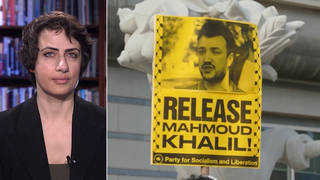
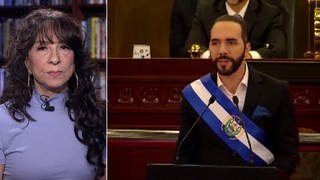
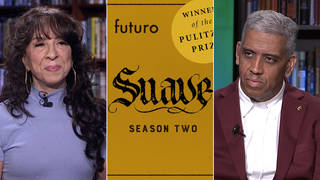
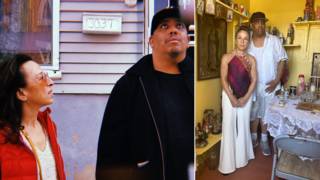
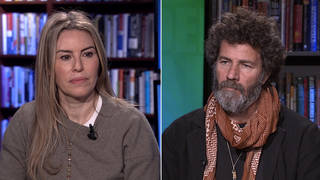
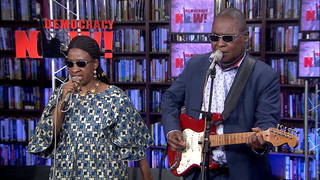
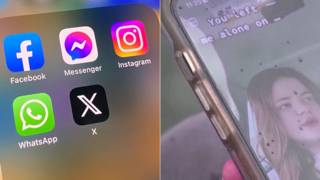

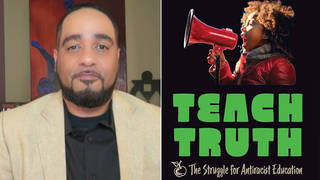

Media Options